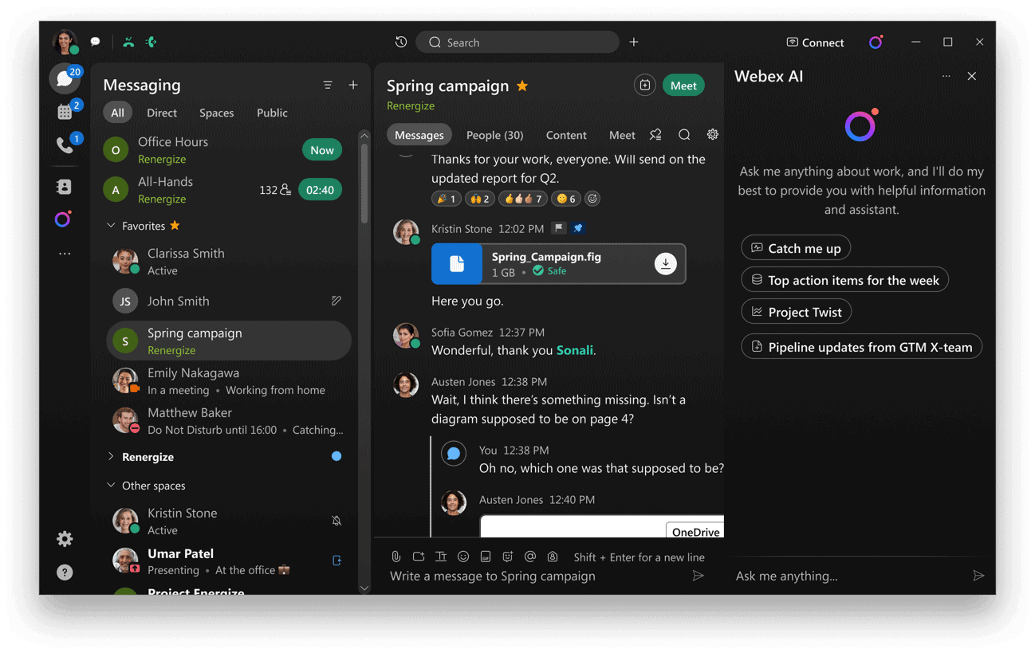Latest updates are not just extra features, we hear from Cisco EVP Jeetu Patel, but are changing the platform in a fundamental way.
This week Cisco organized WebexOne, the annual event at which the company aims to show the world all that Webex can do and how it keeps getting better. It’s clear that the company continues to believe in Webex, even if the battle with Microsoft Teams and Zoom seems unwinnable for Cisco. They understand that at Cisco, too. That is, that is how we interpret last year’s announcement that Webex hardware was made compatible with Microsoft Teams.
Accepting its position relative to competitors, however, does not mean that innovation is out of the platform. Far from it, in fact. According to Patel, who is responsible for the security and collaboration portfolio at Cisco, this week’s WebexOne is the edition with the most “strategic innovation” in history. That means even more innovation than a few years ago, when Cisco overhauled the entire UI of Webex and rolled out 800 updates.
Now, Patel is no stranger to bold statements. For example, during the corona period he promised that virtual meetings via Webex would be up to ten times better than physical meetings. We didn’t believe any of that then and still don’t. Not so with this week’s bold statement, though. It could very well be true. We discuss why we think so in this article.
Distance 0 thanks to AI
It should come as no surprise that AI plays an important role in this week’s announcements. That has been one of the guiding principles in developing the current updates. “We want to build AI in such a way that it impacts the entire platform,” Patel states. That should enable Cisco to move Webex to (distance 0), as he calls it. By this he means that it no longer matters whether you participate in a meeting virtually or physically. “You no longer feel the distance,” he indicates. That’s where things need to go in this hybrid era. AI can make that happen, is the idea.
Real-Time Media Model (RMM)
The first update we discuss in this article has the somewhat confusing acronym RMM. Up until now, that meant Remote Monitoring and Management to us. This is something that MSPs, among others, use a lot to monitor their customers’ environments. At Cisco, however, they mean something else by it – Real-Time Media Model.
RMM focuses on all communications that do not involve (spoken) language. That’s traditionally where the innovation is in a platform like Webex. Consider, for example, the addition of real-time translation a few years ago. Or the automatic generation of a transcript of a meeting. “That in itself is great, but a lot of context is also lost if you focus only on language,” according to Patel. Think about arm movements, whether someone gets up and walks away from the screen and facial expressions. That’s what Cisco wants to add to Webex with RMM. RMM will sit alongside LLM, giving more context to its output. “You don’t just get a summary of a call, you get context about what happened during that call,” according to Patel.
This linking of RMM to the LLM that Webex uses for a specific task offers many possibilities. If Webex recognizes that someone briefly walks away from a call, it can automatically display a ‘Be Right Back’ message in the screen. This then immediately gives the other participants additional context. The participant who stepped out of the call can be quickly “caught up” by Webex as soon as they return about what they missed.
Ultimately, RMM is a combination of AI and automation. The AI allows different types of communication to come together in a single output. Based on that output, it is possble to automate certain things. Patel, by the way, also realizes that this will not be as easy for all nonverbal communication. Someone briefly walking away from a call is fairly easy to recognize, but how will Webex interpret things like facial expressions and tone/emotion? “Facial expressions are difficult because they are also partly culturally determined,” he admits. So in this first iteration, the main focus will be on the somewhat less subtle issues. However, the goal is definitely to address these difficult parts as well.
AI Audio Codec
A second update for Webex during WebexOne is the AI Audio Codec. From a technical standpoint, we think this is the most impressive. The reason is that with this, Cisco has reinvented the basics of the audio stream, so to speak. With this new codec, Cisco wants to “defy physics as much as possible,” to use Patel’s words. The speed of light and the distances over which communication must take place impose limitations. In addition, you are also often simply dealing with an inferior connection, especially in areas where broadband penetration is not particularly high. With the AI Audio Codec, Cisco aims to minimize the problems this presents.
The basis of the AI Audio Codec is better compression. According to Patel, this compression is up to 16 times more efficient than it has been so far. This makes it possible to send many more packets within the available bandwidth and should result in a better and more stable connection. Not only because it then becomes possible to send more packets that are actually used. It also allows Cisco to send more redundant packets. The more of these you have, the better the signal that remains. If a signal still loses a lot of packets, the AI Audio Codec can re-generate these packets (and take out noise) using built-in AI capabilities.
Ultimately, the AI Audio Codec is about three things, Patel summarizes, “Efficiency, redundancy and reconstruction.” Its impact is quite substantial. In fact, tests have shown that a signal can have 80-90 percent packet loss, after which the audio is still audible. If this is true, Cisco has definitely made a big step in this area.
Super Resolution
To be clear, the AI Audio Codec only focuses on the audio of Webex meetings. For the video component, it does basically nothing, except perhaps that in theory it is now no longer or rarely necessary to disable the video to save the audio. However, Cisco has also come up with something new to make the video stream more efficient, Super Resolution. This allows Webex to scale up thumbnails at the endpoint to a larger size. This means that the signal to the endpoint streams video in thumbnail format and thus requires much less bandwidth.
When asked if this doesn’t have a negative impact on the available compute resources at the endpoint, Patel indicates he doesn’t expect that. “We’re pretty good at compute utilization,” according to him. The proof of that pudding will be in the eating, of course. AI should help take available system resources into account and use them intelligently.
With the AI Audio Codec and with Super Resolution, Cisco reinvented the Webex stream, so to speak. It can do that because it continues to invest heavily in this part of its business. Its experience with Callisto, a technology demonstration of how Webex can be used to communicate with people in space, undoubtedly played a part in this too. That, of course, is the ultimate challenging environment, where limited bandwidth, high latency and thus efficiency are extremely important.
Webex AI Assistant
The last update we want to cover in this article is the replacement of the current Webex Assistant. Again, it is all about AI. Therefore, the name has been changed to Webex AI Assistant. It is not an update to the basics of Webex such as the aforementioned innovations (RMM, AI Audio Codec, Super Resolution), more of a front-end in which all kinds of smart things can be done partly thanks to these innovations.

The old Webex Assistant already included the ability to get a transcript and even real-time translations. The Webex AI Assistant goes a lot further. It can generate a summary of a meeting. If someone arrives at a meeting 15 minutes late, they can immediately get a summary of the first 15 minutes and then just join the meeting. Patel also mentions suggestions around the tone of a response and more generally suggestions for responses based on what has already been discussed in the messages in Webex.
We always find the suggestions tone of voice of written text somewhat patronizing and not very interesting. Being able to respond faster by suggesting responses is helpful. It should even be possible to create a video of meeting highlights. That is also useful. You do not have to read a summary of a meeting, but can watch it in one minute on video. Of course, this would require the Webex AI Assistant to choose the right pieces of the meeting. That will partly be a matter of trusting the technology, and will take some getting used to.
The success of the Webex AI Assistant will also largely depend on the underlying AI model. On that, Patel is clear: “You can plug any foundational model into the Webex AI Assistant.” In doing so, the cost of such models will have to be weighed against their quality. In general, organizations will not need a model with a huge number of parameters, because it will often be a relatively limited data set it has to work with.
Conclusion: fundamental updates determine the future of Webex
In this article, we’ve covered quite extensively the updates Cisco announced this week. We could also have stuck to a somewhat shorter piece, but deliberately did not. The reason is that this is not just about some additional functionality. Cisco has shaken up some basics with the introduction of the AI Audio Codec and Super Resolution. This can have a very substantial impact on the quality of the signal and therefore meetings. With RMM, it has the potential to add a great deal of context to (hybrid) meetings, and with the Webex AI Assistant, the user experience of Webex could get a solid boost. Whether it really goes toward distance 0, we doubt. But in any case, Cisco seems to want to do everything possible to get as close to this as possible.
However, everything starts with a good audio and video signal. As Patel puts it at the end of our conversation, “inputs have a big impact on outputs.” The new codec and RMM are only the beginning. From now on, we will see an acceleration in the development of the Webex platform, he promises.
Also read: Webex gets makeover: to Webex or to Zoom, that’s the question
